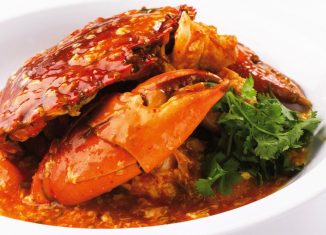
The Lion City isn’t just home to the famous Merlion and Marina Bay Sands. Aside from its unique architecture and beautiful tourist spots, the country is also a place that offers a variety of dishes – from heavy meals to desserts – influenced by the different flavors of Singapore’s neighboring countries. Here we have created a list of food you should try in this small yet magnificent country. Allow yourself to explore and delve into the rich culture of the country by experiencing its cuisine. These dishes will definitely make you feel like you have traveled to another country, and would even take you to a lane of history.
When planning to visit Singapore, prepare to feast not only on the scenery but also on the food, because these must eat dishes are definitely something that you should add to your bucket list.
-
Laksa
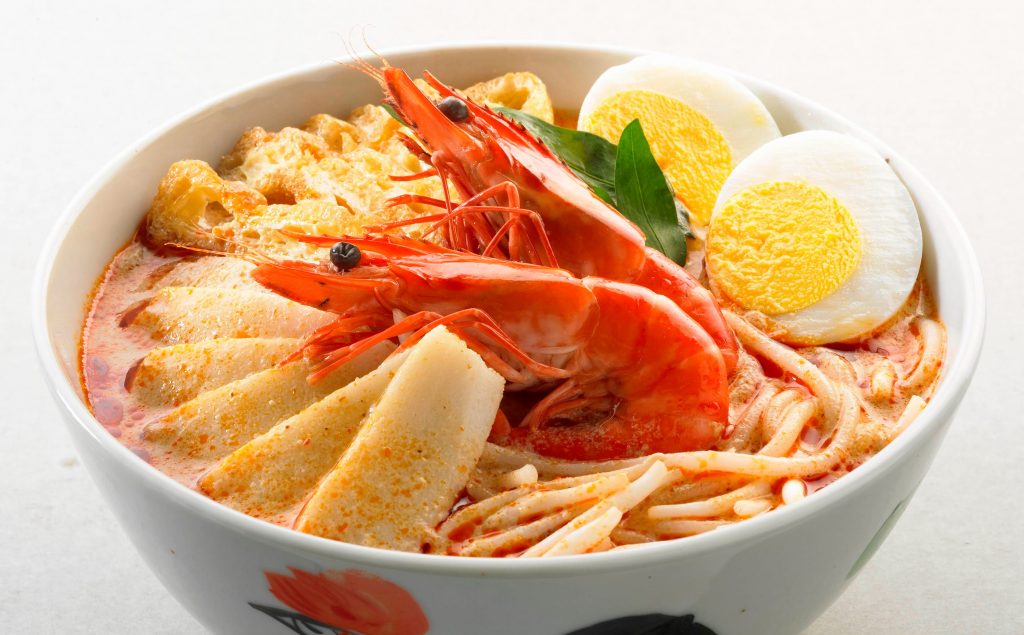
Laksa is a combination of Chinese and Malay flavors, and is one of the national dishes in Singapore. It is made up of noodles, gravy or curry, and some protein, vegetables, and herbs. Some types of laksa have more coconut milk in them while other types are more water based.
There are many different types of laksa in Singapore. Penang laksa has a tamarind-tang flavor and is usually found in Malaysian regions. The curry-like Sarawak laksa is predominant in Singapore. Katong laksa is the most famous type, and it is a unique Singaporean variant.
A Peranakan (Straits-born Chinese) inspired dish, the Katong Laksa has a yellow-orange spicy soup stock flavored with coconut milk. It contains dried shrimp, prawns, fishcake, cockles, and other toppings. Its thick vermicelli noodles are cut into shorter pieces so that you can easily get them with a spoon. Some stalls do not get you chopsticks, they only provide a spoon to eat the laksa. Katong laksa can now be found in almost every part of the country, and a lot of stalls have been trying to copy the original flavors of this tasty dish.
-
Hainanese Chicken Rice
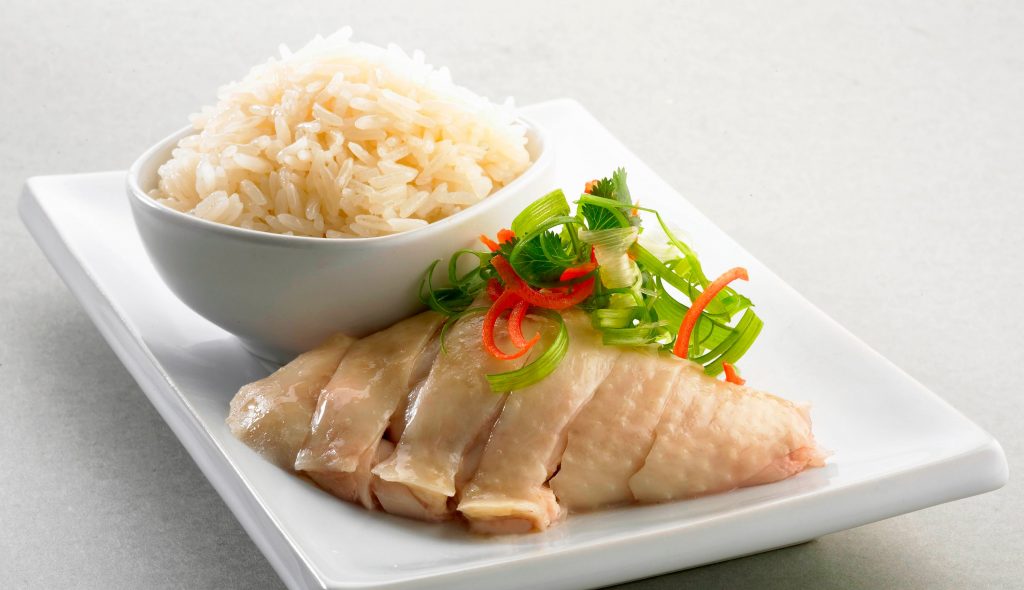
Another one of Singapore’s most famous dishes, Hainanese chicken rice can be found in almost every eating spot in the country – from hawkers to restaurants. These eating spots offer similar recipes at varying prices and in different serving size. Some serve the whole chicken while some serve bite-sized chicken rice meals, all paired with some chili and ginger paste. This dish is also considered to be one of Singapore’s national dishes.
The meal is cooked the Hainanese way – by boiling the chicken or blanching it in water and then putting it in cold water once it is fully cooked. Some would also roast the chicken or braise it in soya sauce. The Singaporean style recipe is also influenced by Cantonese flavors which is why they use the tangy red chili sauce dip. The way the rice and chili is crafted is what makes this dish extraordinary. The rice is cooked in chicken stock with ginger and pandan leaves, and the chili must have a balance of spicy and sour flavors.
The Hainanese chicken recipe has been influenced by the early Chinese immigrants from the island of Hainan located in the southern coast of China. The locals of Hainan call this dish the “Wenchang Chicken.” They pair the chicken with oily rice and use ground green chili as a dip.
-
Bak Kut Teh
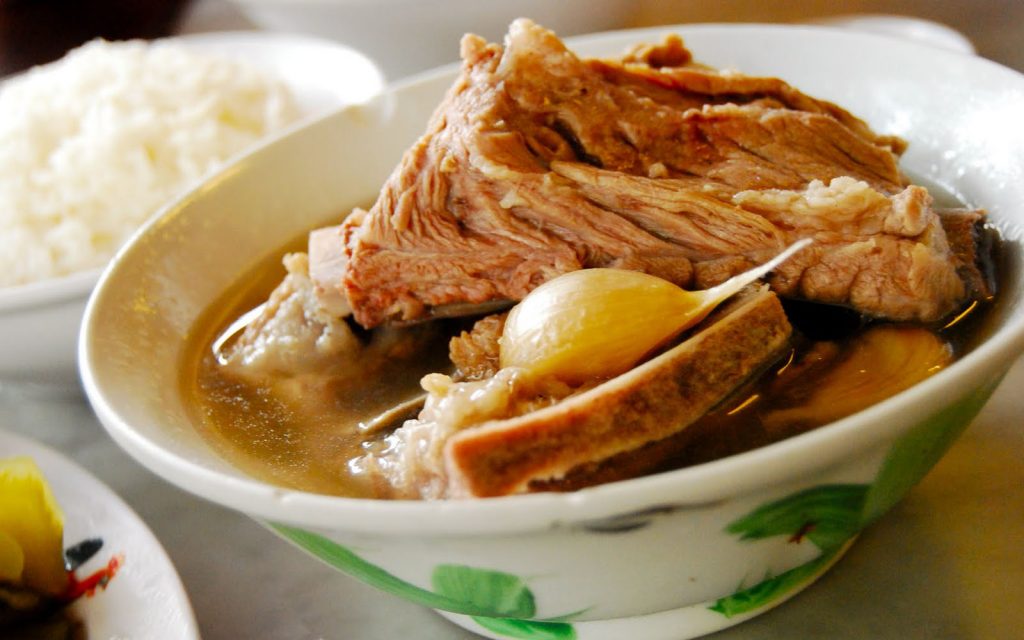
Bak Kut Teh, which literally means pork bone tea, is a dish made up of pork ribs simmered into a broth of fragrant herbs and spices like garlic, cinnamon, star anise, and coriander. Despite its name, this pork bone tea dish does not contain any tea. Some explanations would say that the meal is paired with some Chinese tea, while others would say that the color of the soup is similar to that of the tea.
Bak Kut Teh is said to have originated from the Fujian province of China, and was introduced in Singapore through the immigrants from Hokkien who transferred to the region. This dish is said to be a hearty and filling breakfast for the Chinese coolies before they start their work.
This pork rib soup recipe is usually eaten with steamed rice, dough fritters, vegetables, and braised bean curd skin. It is served with some soy sauce for the dip, where chili and minced garlic could be added. It is preferred to pair the dish with some Chinese tea to help wash down the oil and fat from your meal.
There are three famous types of Bak Kut Teh – Teochew, Hokkien, and Cantonese.
Teochew Bak Kut Teh has a light-colored soup seasoned with some pepper, soy sauce, and garlic.
Hokkien people enjoy strong flavored soups, which is why their Bak Kut Teh recipe has more herbs and soy sauce, making the dish darker, thicker, and more fragrant.
The Cantonese are fond of herbal soups, which is why their take on Bak Kut Teh is by adding some medicinal herbs to the recipe. They also add some mushrooms, Chinese cabbage, and dried tofu.
There are also some other variants of Bak Kut Teh that do not contain any pork. Some of these recipes would substitute pork with mutton, beef, or ostrich meat. This new variety was introduced to cater to the Muslim community. Many Bak Kut Teh stalls can be found in Geylang or Balestier Road.
-
Popiah
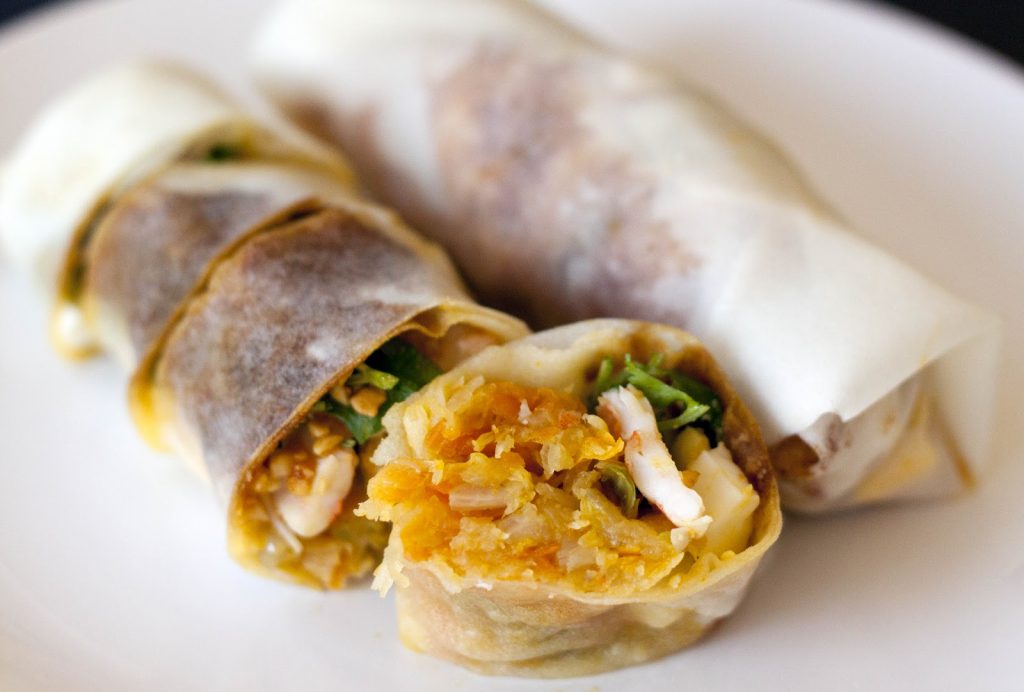
Popiah (Teochew for ‘thin pancake’) is a spring roll common in Taiwan, Singapore, Malaysia, and Thailand cuisine. It has a soft paper-like crepe wrapper made from wheat flour mixed with water and a dash of salt. Popiah is made up of a wrapper stuffed with cooked vegetable and meat filling. When deep fried, it becomes a spring roll. When raw, it is called a popiah.
It is said to have originated in the Fujian province and came from the spring roll that was usually eaten during spring when vegetables were abundant. Now, popiah is eaten as a snack or used to pair with a main dish. You can find this dish in most hawker centers. ‘Popiah parties’ have also become popular, wherein wrappers and fillings are laid out and people get to decide on the ingredients they want to add.
-
Hokkien Mee
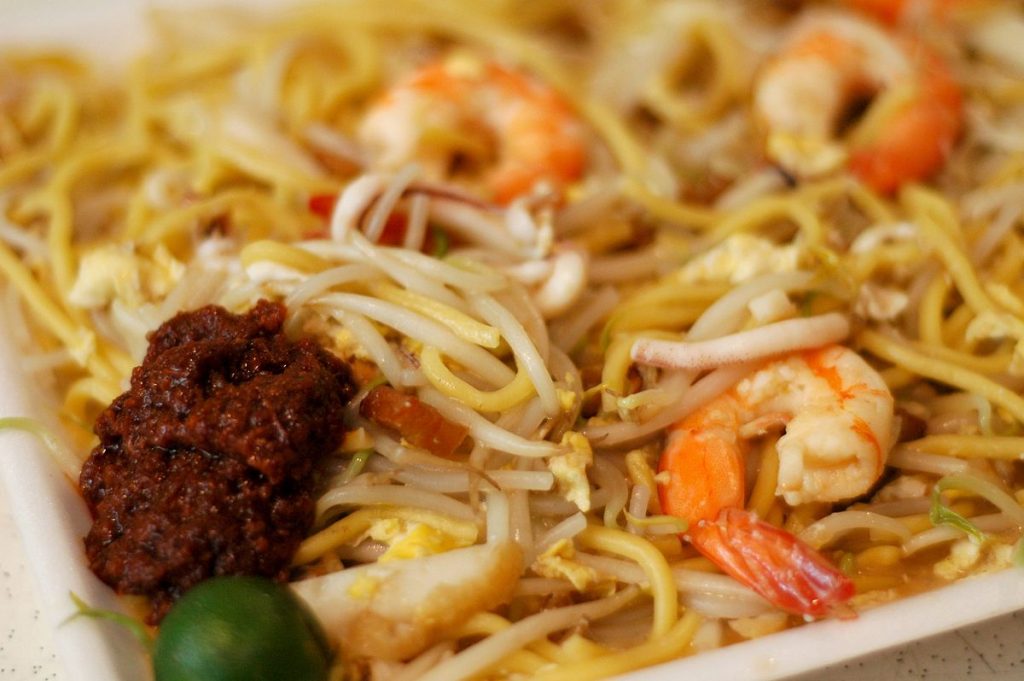
Hokkien Mee is a Singaporean and Malaysian dish that is said to have originated in the Fujian (Hokkien) province of China. This dish is usually made up of egg noodles and rice noodles stir-fried with egg, some slices of pork, prawns, and squid. It is garnished with some vegetables, pieces of lard, sambal sauce, and lime.
Malaysian Hokkien mee is called Hokkien Char Mee which translates to Hokkien black noodles, while the Singaporean version is the Hokkien Hae Mee, which means Hokkien prawn noodles. The dish is usually referred to as “Hokkien Mee,” but the type of dish served would vary depending on the country you are in.
Singaporean Hokkien prawn mee has its stir-fried noodles steeped in a stock made out of pork bones and prawn heads. The dish consists of some yellow noodles and some thick vermicelli, mixed with some praws, squid, strips of pork belly, and egg, and you also have the option to add some crunchy fried pork lard. It is served with some sambal chili and lime.
-
Chili Crab
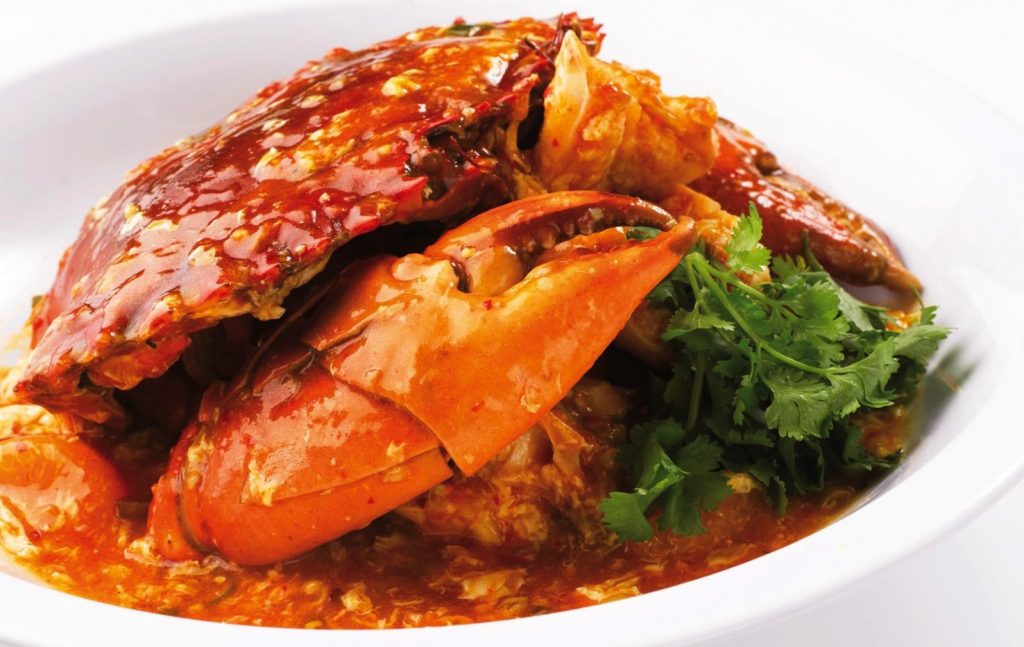
Chili Crab is said to be on of Singapore’s national dishes which can be found in most seafood restaurants all over the island. It is a semi-thick, sweet, and savory dish with tomato and chili in its sauce. Chili crab is not as spicy as its name indicates. Mud crabs are commonly used for the recipe and are stir-fried in its sauce.
Traditionally, it is eaten with bare hands to savor the crab meat with its sauce that has a balance of sweet and spicy flavors. Restaurants would provide a washing bowl or some damp towels to clean your hands after the meal. The sauce is what makes the dish extremely tasty. Sometimes, people would even dip some fried or steamed buns into the sauce.
This dish started from a pushcart business, and has now become a world-famous dish served in seafood spots in the country.
-
Ice Kacang
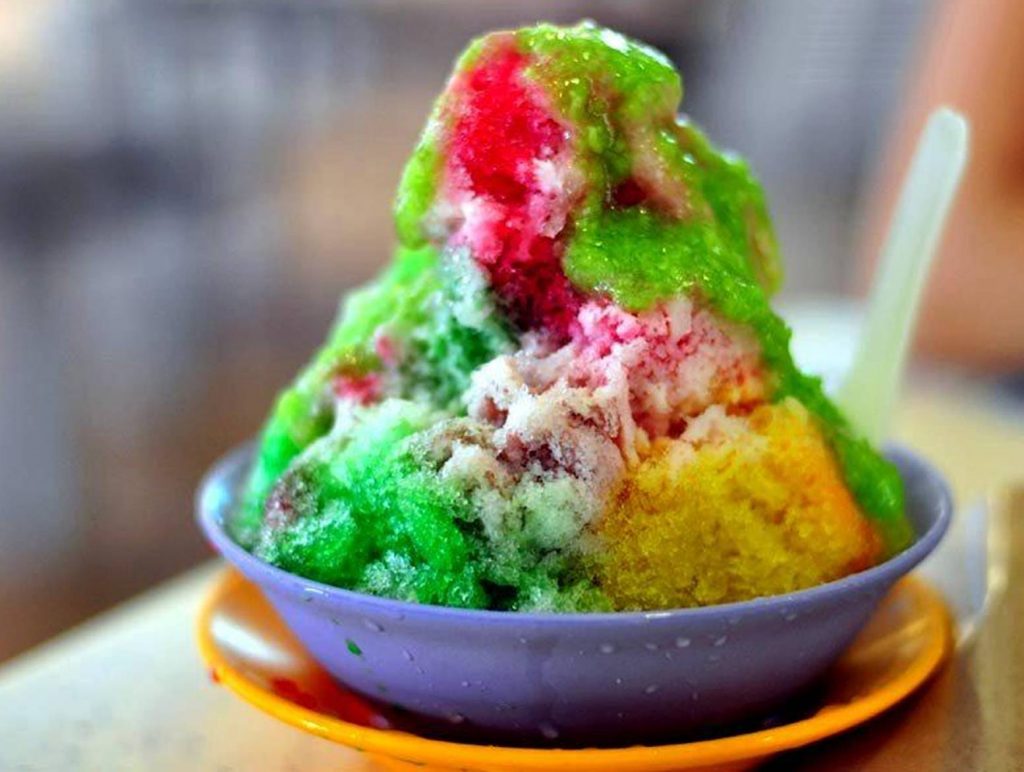
Ice Kacang, which literally translates to ice peanuts, is a Malaysian dessert also famous in Singapore and Brunei. It used to be made by hand through manually cracking the ice, but now, an ice shaving machine is used and the process has now become more motorized.
This famous dessert has evolved into several versions through the years – from simple ice balls coated in colored sugar syrups to the modern Ice Kacang which is a mountain of ice topped with a variety of common and unique toppings. Originally, this dessert is made up of shaved ice and red beans only, but this recipe has now changed, consisting of a wider variety of ingredients. Ice Kacang now comes in different bright colors with some fruit cocktails and dressings. The newer types of Ice Kacang comes with some aloe vera, nata de coco, cendol, or ice cream. The dessert will then be drizzled with evaporated milk, condensed milk, or coconut milk over the ice. Some stalls would even top it with durian or chocolate syrup.
This dessert can be found in hawker centers, food courts, and some coffee shops. Each stall would serve different types of Ice Kacang that would set them apart from the rest. One of the most famous types of Ice Kacang right now are those colorful ones topped with some peanuts, syrup, and other toppings.
-
Roti Prata

Roti Prata is a crisp, soft, flatbread sold mostly by Indian or Muslim stalls in coffee shops or hawker centers. This dish literally means ‘flat bread,’ and has formed part of the Indian cuisine in the country. Singapore sells two common types of roti prata – plain prata and prata with egg. Nowadays, stalls and eateries add a twist to the simple prata dish by adding some mushrooms, bananas, sugar, jam, chocolate, or ice cream to the dish. Most people have roti prata as a staple food, although it is often served for breakfast.
This famous bread was brought to Singapore via the Indian immigrants. It is said to have originated in the Punjab area since wheat dishes are prominent in the Punjabi diet. Others would say that it was brought by the Muslim conquerors also specialized in bread making.
Roti Prata is made out of flour, ghee or margarine, and salt as its basic ingredients. To form the dough, water is added and then it is kneaded. The way the dough is kneaded is important to make a soft and pliable dough. It is cut into smaller pieces, and then it is flattened in a specific process until it is made thin and stretched. Shaping the dough is considered the most difficult part of the prata-making process.
This dish is best eaten with fingers, by tearing the bread into bite-sized pieces and dipped into curry. However, in Singapore, the dish is usually served with a fork and a spoon or knife because of the variations of Roti Prata that they serve. It is crispy on the outside and soft on the inside, and with the many different versions which include sweets now being sold in eateries, this dish has also been transformed to a dessert.
-
Duck Rice

Duck Rice
Duck rice is a Singaporean Chinese dish, similar to that of the Hainanese chicken rice. It is made up of braised duck or roasted duck, paired with some plain white rice. This dish is usually cooked with some yam and shrimps, and served with a thick dark sauce and some side dishes like hard boiled eggs, salted vegetables, or bean curd.
There are two known versions of the duck rice, one influenced by Hong Kong and the other is a Teochew version. The Hong Kong style duck rice uses white rice and a duck drizzled with braised sauce. The Teochew style uses braised yam rice, and a boneless braised duck meat – chopped into thin slices for convenience when eating. Duck rice can be found in most hawker centers and eateries around Singapore.
-
Char Kway Teow

Char kway teow, which translates to ‘stir-fried rice cake strips’ in English, is a noodle dish known in the countries of Malaysia, Brunei, Indonesia, and Singapore. The dish is made out of rice noodles (usually flat) that are stir-fried with some Chinese soy sauce, chili, a little amount of belachan, prawns, small clams, bean sprouts, and sliced chives. Egg is usually fried with the dish, along with slices of sausage, fishcake, bean sprouts, and other ingredients – all sautéed in pork fat.
Some people would consider char kway teow unhealthy because of the amount of fat in the dish. Historically, this dish was intended to be served to laborers, and the fat it contains and its inexpensive price made it a good and affordable way for them to get the energy and nutrients they need for the day. This used to be sold by fishermen or farmers who were also vendors in hawkers for additional income.
-
Kaya Toast
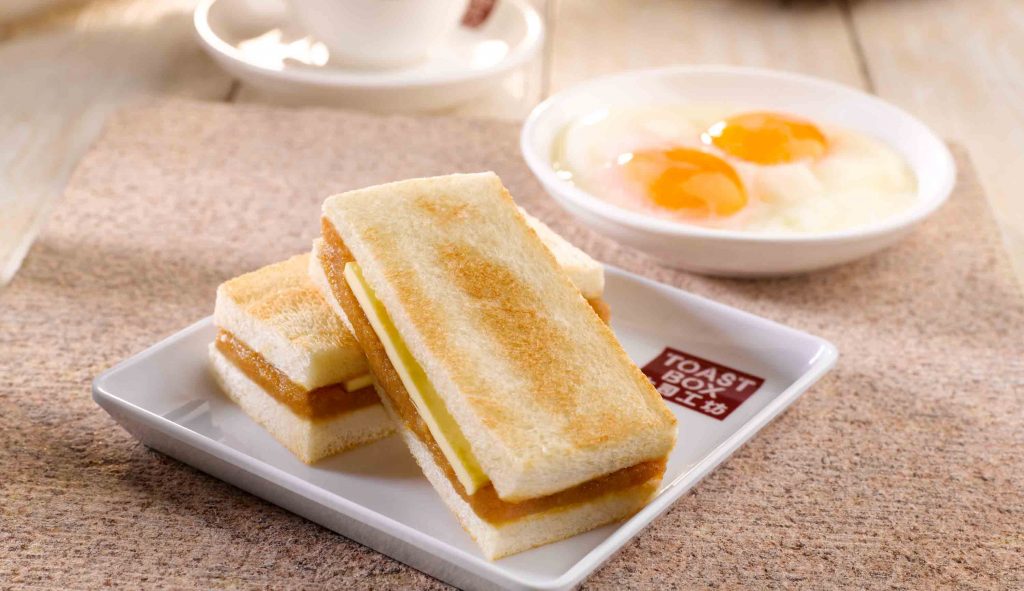
Kaya toast is a popular snack served in Singapore and Malaysia. It is a toast served with coconut jam (called Kaya), coconut milk, eggs, pandan, some margarine or butter, and topped with some sugar. This snack was brought by the Hainanese – specifically from the founders of a coffee stall located in Singapore – when they decided to expand in shopping malls around the country.
It is mainly prepared on toast, but crackers could also be used as an alternative. The toast from this snack could be charcoal-grilled or toasted in slices, with some cold butter and kaya enveloped in the toast. This dish is a popular staple food for breakfast and is sometimes paired with some soft-boiled egg along with some soy sauce and pepper as dip. It is best paired with some coffee (‘kopi’) or tea (‘teh’).
-
Rojak

Rojak is a local salad dish usually found in Malaysia, Singapore, and Indonesia. The term means ‘eclectic mix’ in Malay, and has lived up to its name since the dish is a combination of several different ingredients and flavors blended into one recipe. It is made up of mixed fruits and vegetables and dough fritters. The dish has a sticky dark sauce, and is topped with some chopped peanuts and ginger flowers.
The rojak’s sauce is made up of sugar, lime, and fermented prawn and chili paste. It is mixed in a wooden bowl with a wooden spoon. This is what makes or breaks the dish – it must have a good balance of sweet, sour, and spicy flavors. The ingredients are only poured and mixed into the sauce once the sauce has been completed. Some of the mixed ingredients are kang kong, beansprout, cucumber, Chinese turnip, chopped pineapples, mangoes, unripe rose apples, dough fritters, and bean curd.
Rojak has several types, especially those from the Indonesian and Malaysian variants. Some have rice cakes and peanut sauce in it. The rojak can be found in most Chinese stalls in hawker centers around the city.
-
Satay
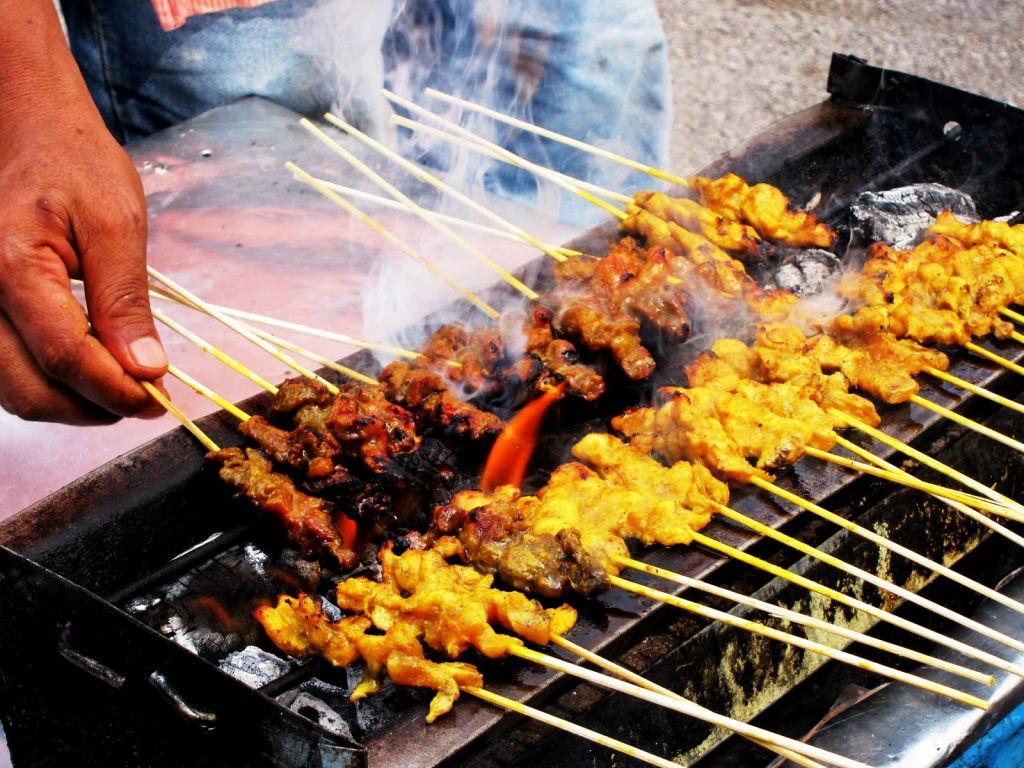
Satay is a kebab-like dish that has been adapted into the Asian cuisine from the Arabs. Arabs were known for meat skewering, and because of the spice trade, the Arab traders were brought to Southeast Asia and their cuisine spread to some parts of the region.
Satay is made up of grilled skewered meat that were cut into bite-size pieces and is paired with a peanut sauce dip. The meat is marinated in many different spices that also help make the meat tender. It is served with a special peanut sauce made from ground peanuts and some spices like coriander and cumin seeds.
Usually, the meat used for satay are beef, mutton, lamb and chicken. Pork can also be used for non-Muslims. This dish is usually paired with steamed rice.
There used to be a Satay Club – a line of stalls selling satay – during evenings near the Esplanade. However, it was demolished in 1995 to make room for other developments in the area. Satay can now be found in hawker centers around the country.
-
Fish Head Curry
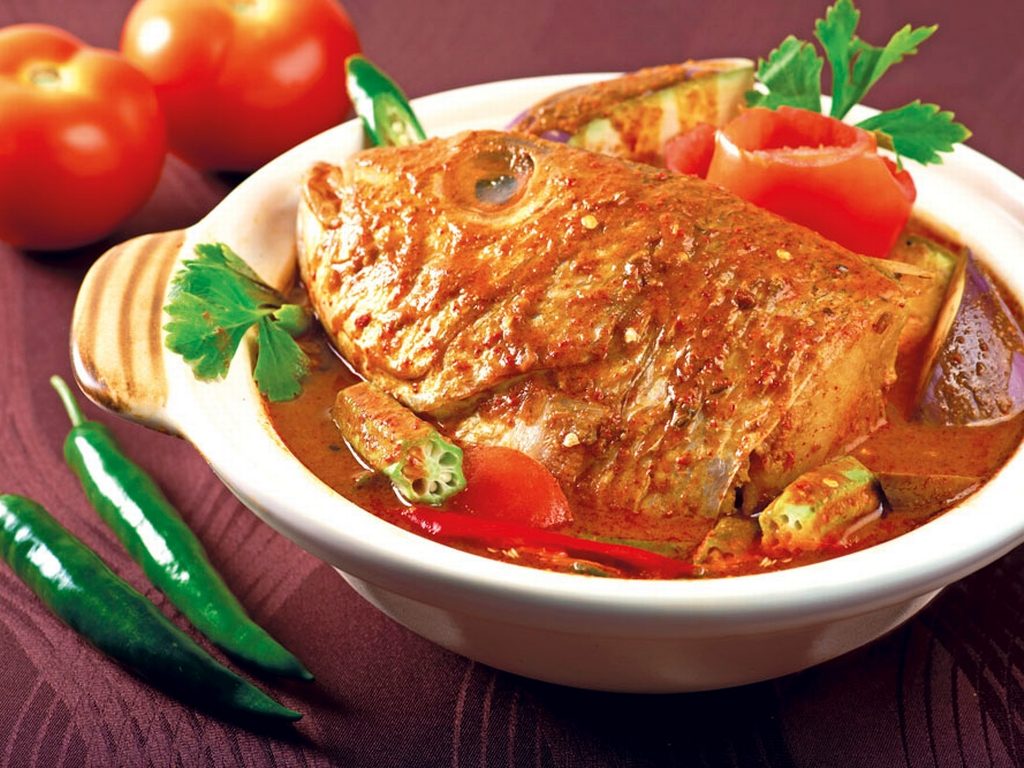
The fish head curry dish is unique to Singapore, with a combination of Indian curry spices and the Chinese delicacy – the fish head. This recipe used to be made and sold only in a small shop behind Cathay cinema, but once its demand increased, it started to spread to different areas.
The curry is inspired by the traditional Indian fish curry recipe, with a thick sauce filled with a mixture of spices. This is served in Indian and Chinese restaurants, and are usually placed in a clay pot. There are many versions of this dish, other restaurants would add some tamarind paste on the curry to add a little bit of sourness to the dish while some would put in some coconut milk to make it creamier.
When eating this dish, the first part to be eaten from the fish head is the area around the cheeks. The finale would be scooping the eyes. It is best paired with rice to soak up the fragrant and flavorful curry.
-
Nasi Lemak
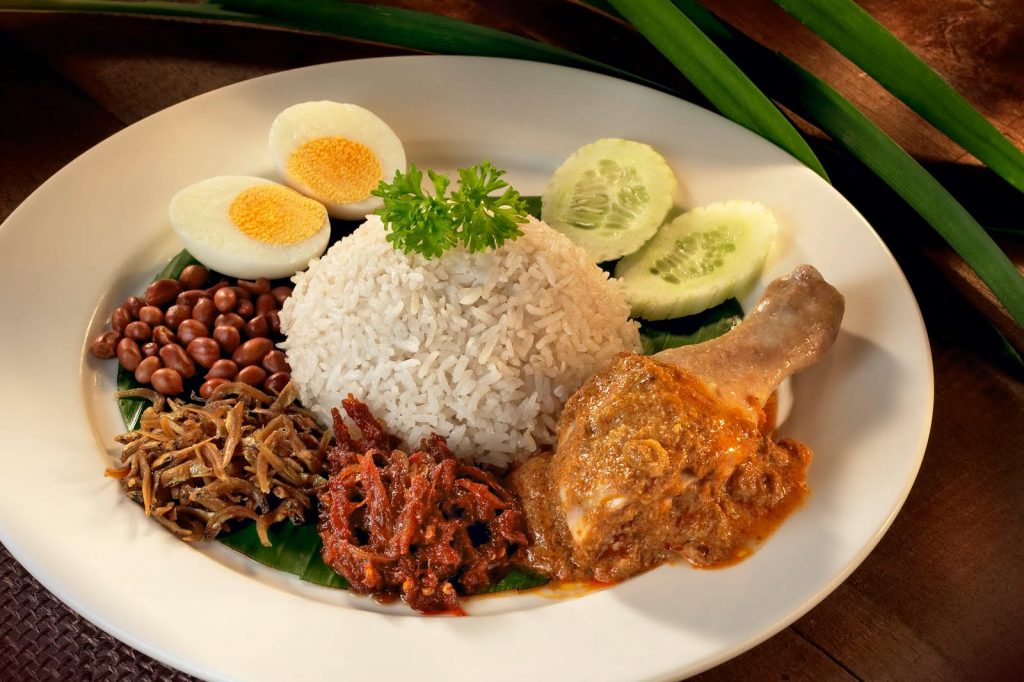
Nasi Lemak, a Malay word which translates to ‘rich rice,’ is a dish rich in coconut cream, making the dish extremely delicious. It has a great symphony of flavors – from the aromatic rice soaked in coconut milk and pandan leaves, to the fried fish or chicken wings. This is paired with some grilled fish past, fried anchovies, peanuts, eggs, cucumbers, and spicy chili paste.
Traditionally, the rice in cream is served with fried fish, kang kong, and sambal. The sambal is its signature condiment, which is made up of some chili, shallots, garlic, shrimp paste, and sometimes, some lemongrass. To add a tangy flavor, sugar and tamarind are added.
Other variants of this dish can now be found. Some would add garlic, shallots, some ginger, and a few stalks of lemongrass into the cooking process. Now, aside from the traditional side dishes, fried chicken wings, barbequed fish paste, pickled vegetables, and long beans are newer options for sides. This dish is one of the cheapest that is sold in hawker centers and eateries.
-
Chai Tow Kuay
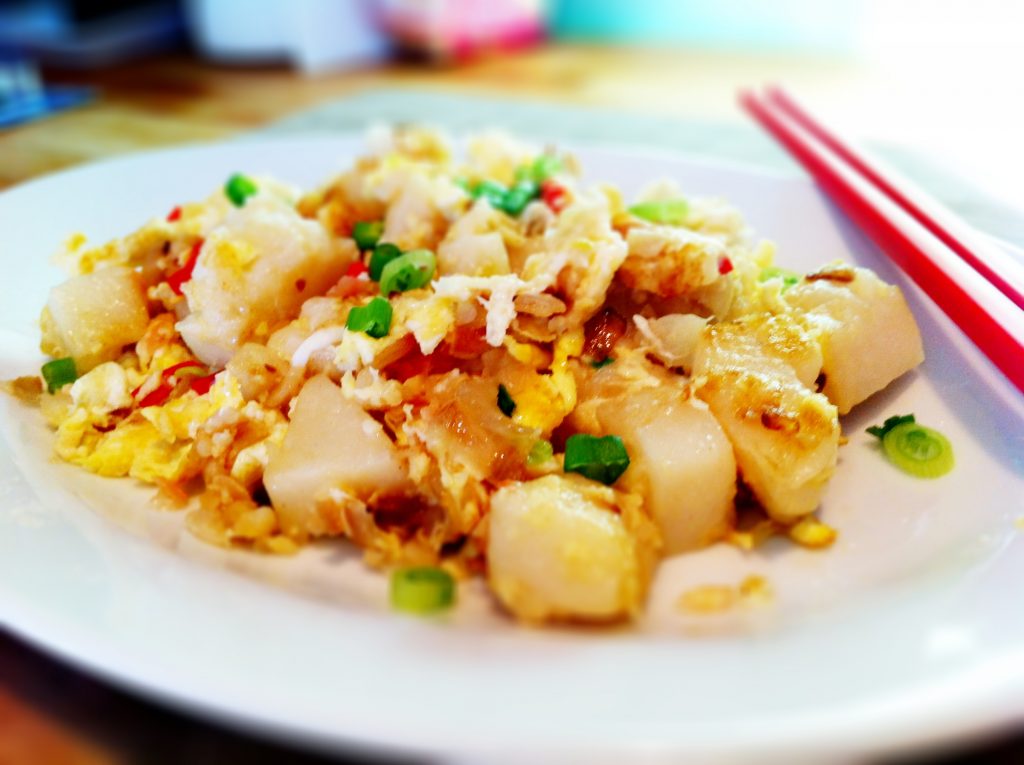
Chai Tow Kuay, or fried carrot cake, is not similar to the famous moist cake dessert that is sold in bakeries. This dish does not contain any orange carrot at all. However, it does have some white radish in it, which some people would call a white carrot.
The main ingredients of this cake are rice flour and white radish. The cake mixture is steamed, cut into cubes, and then fried with some garlic, eggs, and ‘chai poh’ (preserved radish).
The dish is said to have originated in the Chaoshan province of Southern China, and was brought to Singapore by the Teochew immigrants. It is made with rice flour, and is marinated with black sweetened soya sauce and fish sauce before they are fried with some eggs., oysters and prawns.
This rice cake can be found in many hawker centers around the country, and is served with some sweet dark soya sauce, or in its original plain variant.
-
Murtabak
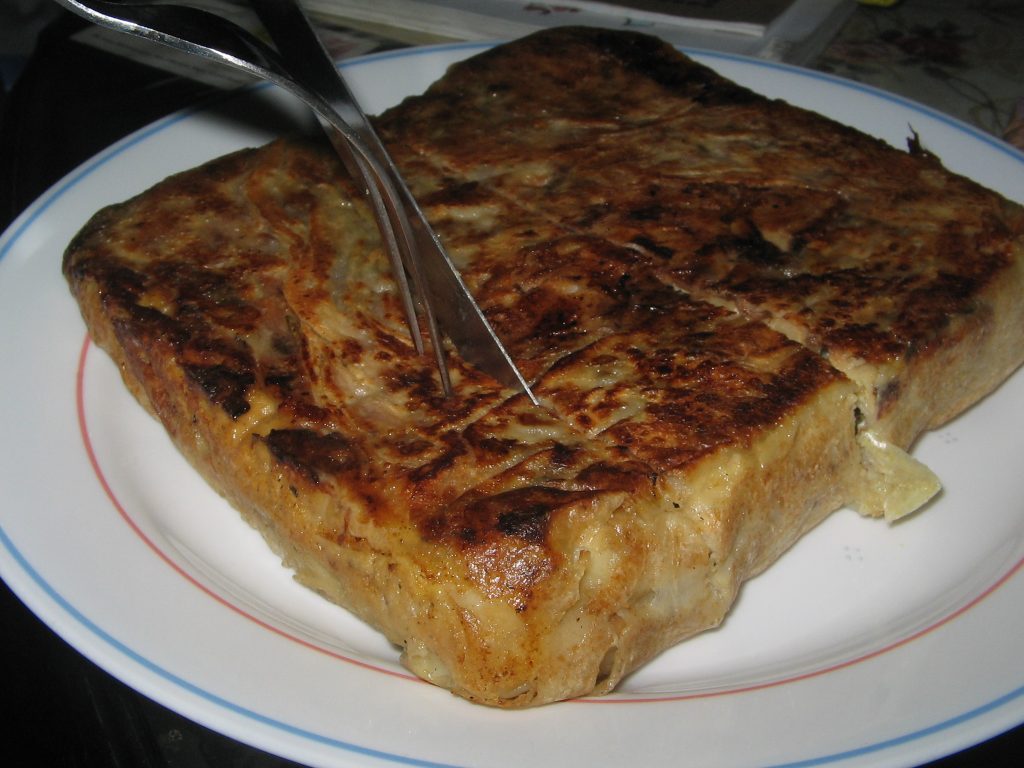
Murtabak is a stuffed pancake dish commonly found in Saudi Arabia, Malaysia, Singapore, Brunei, Indonesia, India, Yemen, and Thailand. The ingredients used and the way it is called would differ depending on which country you are in.
There are multiple murtabak variants, but the ones in Singapore usually have beef, chicken, or mutton as filling. This is served with curry sauce, together with some cucumber in ketchup. You can also add some salty soy sauce and pepper, or sometimes, it is eaten with condensed milk, melted butter, honey, or syrup. Most of the time, before it is served, the murtabak is cut into portions. Other versions of this dish would have it served with acar or any pickled condiment like cucumber, carrot, shallots, and chili in sweetened vinegar. A vegetarian version and other variants can also be found in many Indian or Muslim restaurants and hawker stalls in Singapore, especially those near the Sultan Mosque or Arab Street.
-
Putu Mayam
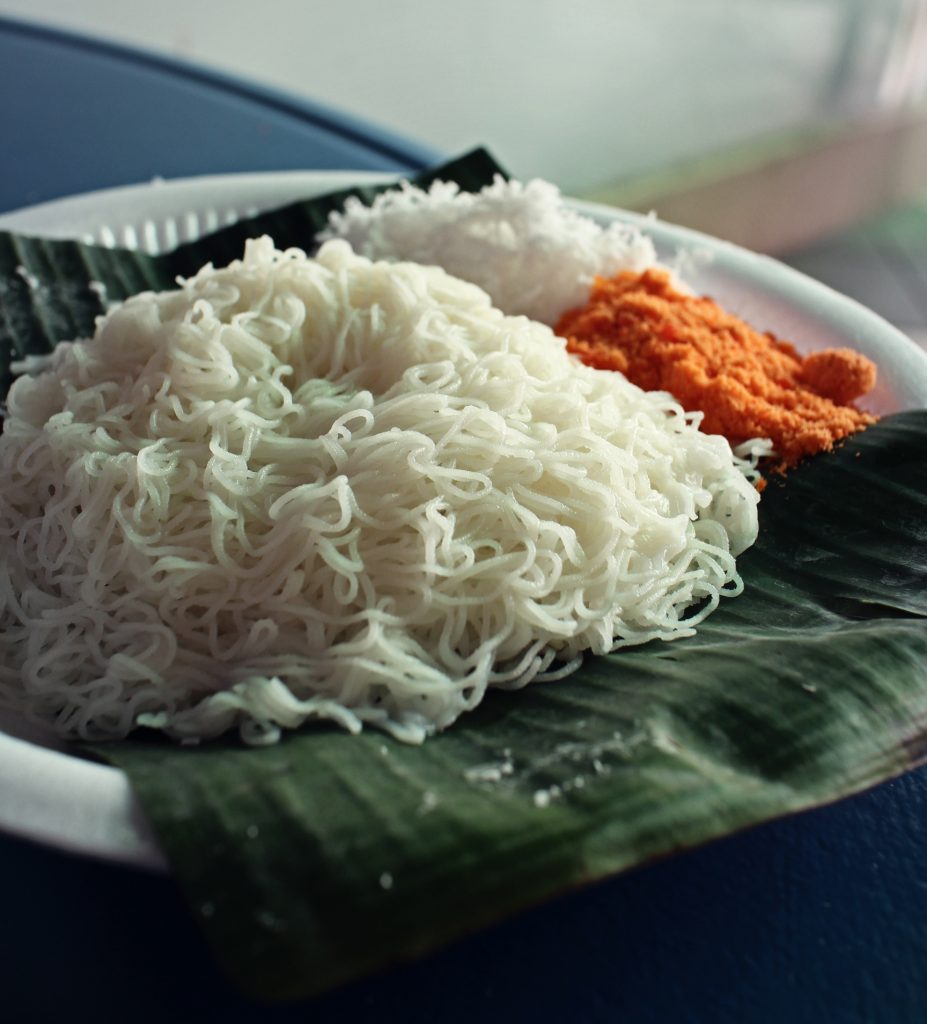
A steamed rice flour noodle snack topped with some sweets like grated coconut and palm sugar, Putu Mayam is a South Indian dish that has also made its way to the Lion City. This snack, which is called string hoppers in English, could also be paired with curry, stew, or chutney. It is usually served for breakfast or dessert.
This snack is commonly eaten in Singapore, Malaysia, India, and Sri Lanka. Rice flour, salt, and water are used as main ingredients. The rice is soaked in water for hours before it is grinded into flour, and is then mixed with water and salt, forming a paste. Some would add pandan leaves to add more flavor and fragrance to the recipe. The mixture is then molded to make a round, lacy shape, which is then steamed. Aside from the mentioned accompaniments (ingredients and dishes) above, this dish can also be made cold to serve as dessert.
Putu mayam used to be sold by roving south Indian vendors in Singapore by balancing a basket filled with this snack on their heads. Now you can find this dish in hawker centers and food courts.
-
Kambing Soup
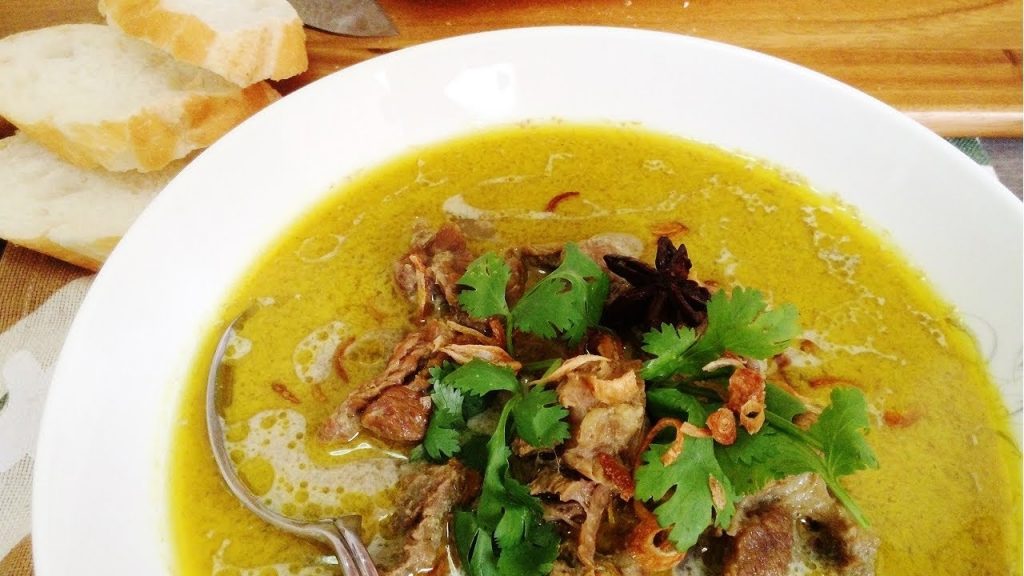
Kambing soup is made up of goat meat and some spices, and was influenced by the Indian Muslim community. It has a spicy mutton soup, and the goat meat is cut into smaller chunks and is stewed into flavorful spices – such as coriander, fennel, cumin, star anise, and cinnamon. It is paired with some toasted bread.
Chicken and beef could also be added to the broth aside from mutton. Before the meat is cooked, it is first braised in curt powder. The soup broth has a greenish-yellow color due to the spices used, and it is topped with some coriander leaves and sliced shallots once it is served.
This soup now has many different variants. Some are made of beef and mutton, while others use chicken stock. Others would even use ox trike, ox tongue, ox tail, or a bull’s penis. One variant even uses a mixture of bull’s penis and goat’s testicles.
-
Ketupat
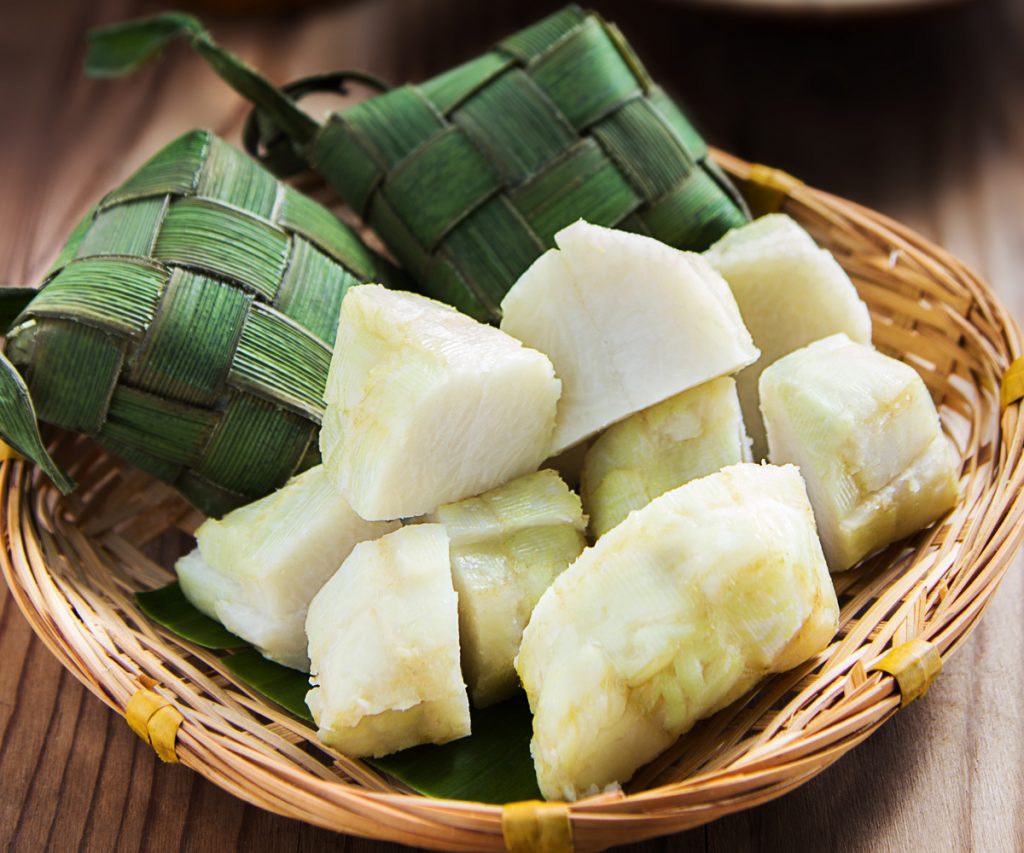
Ketupat is a staple food for Malays. It is a diamond-shaped rice cake made up of cooked rice wrapped in coconut leaves that originated from Malaysia and Indonesia. It is usually paired to many meat dishes like satay or stews, but this traditional version has become less common in Singapore.
The ketupat is shaped into a diamond by means of wrapping the plain rice into intricately woven coconut leaves. The rice is first washed and drained, and then it is spread out on a tray. Stripped coconut leaves woven into box shapes are then partially filled with rice, just enough room for the rice to expand once cooked.
Cooking the ketupat takes hours, and the pot where it is boiled must always be kept full of water in order for the ketupat to be fully submerged. Some would precook the rice in lightly salted water to shorten the boiling process. The longer it is cooked, the longer the ketupat can be kept – it can be eaten for at least two days if refrigerated. Some people would even prefer eating it cold.
-
Mee Goreng

Mee Goreng is a fried noodle dish that is said to be influenced by people from the southern portion of India, but this dish is unique to Singapore. It is a combination of the commonly used egg noodle from the Chinese, mixed with some spices and meat – usually mutton – from Indian cuisine, and some tomato sauce, which is commonly associated with the West.
Aside from mutton, other meat alternatives can also be used, like chicken or beef. The meat is mixed with the egg noodles together with other ingredients like chopped onions and potatoes, some peas, sliced cabbage, and a handful of beansprouts. The dish is then served with finely cut green chili, grilled bean curd, and eggs that could be boiled, scrambled, or fried as toppings. The Chinese noodles are what makes or breaks the dish – they must be well-cooked and crispy. The Singaporean mee goreng once had yoghurt with thin cuts of cucumber for sides, but now they pair it with tomato sauce and chopped cucumber instead.
-
Vadai
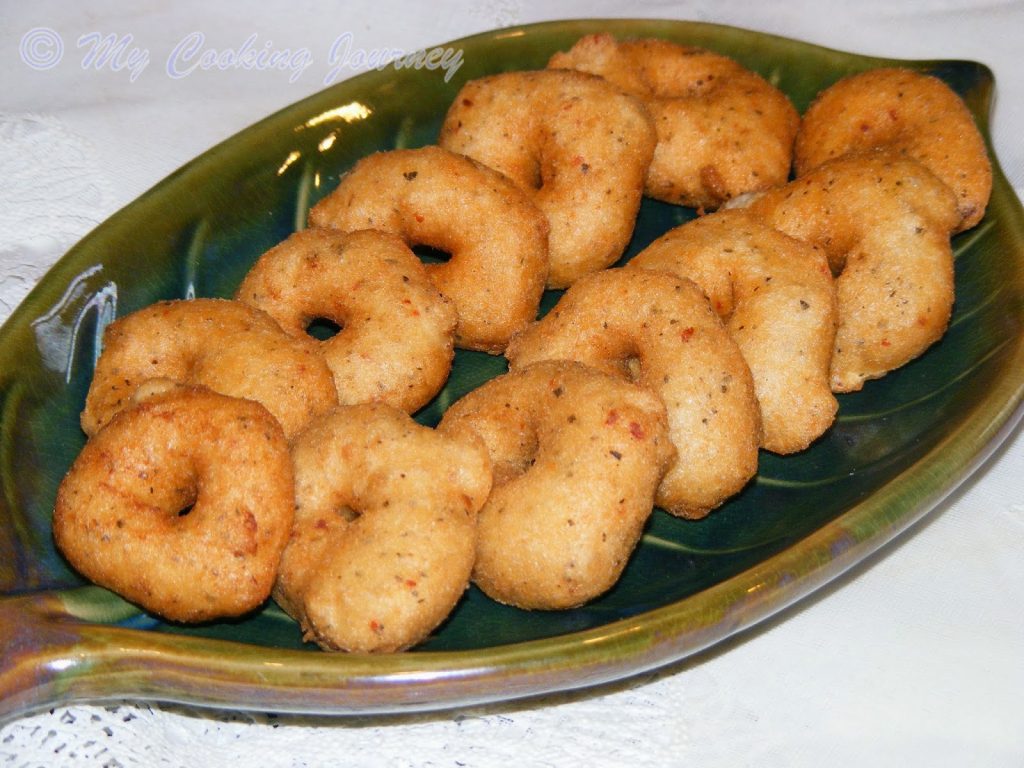
A South Indian snack, Vadai is made up of fermented pulses that are shaped into balls or doughnut form. These are deep fried and produce a crispy exterior and soft interior.
This dish can be made from a variety of pulses – like split chickpeas, yellow pigeon peas, or black gram. Once these pulses are fermented, they are turned into paste through pounding them. Other ingredients like onions, green chili, cumin seeds, curry leaves, and salt are later added to make the mixture more flavorful. Most Singaporeans eat vadai paired with green chili, and the doughnut-shaped ones are usually eaten with some coconut chutney.
Roaming Indian vendors used to sell these snacks in Singapore in its original plain flavor or with some onions and sometimes, even prawn. Now, this snack can be found in several hawker centers around the country.
-
Rendang
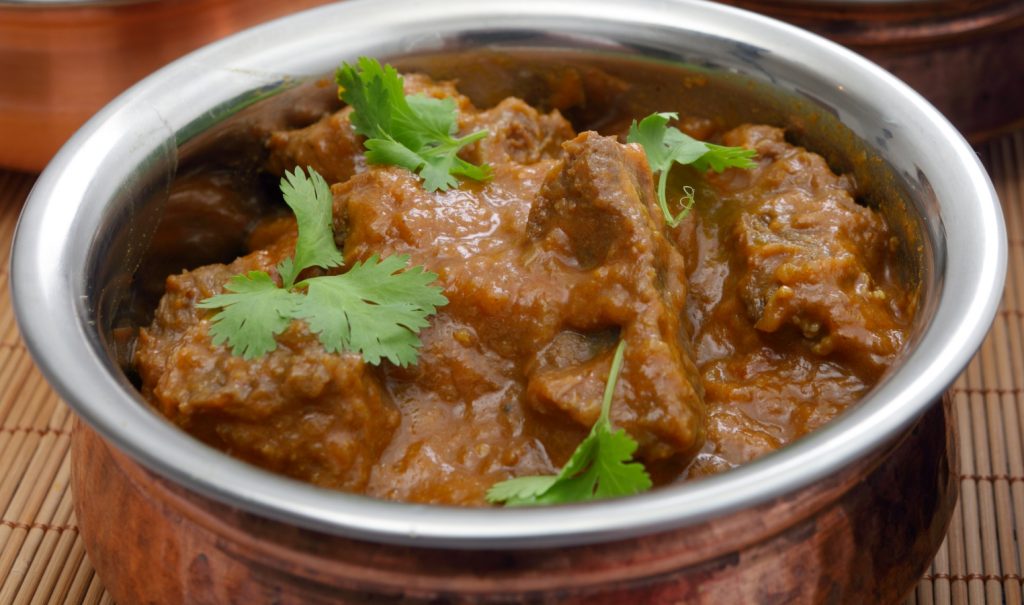
Rendang is a dish usually found in Malaysia, Singapore, and Indonesia. It is made up of meat stewed in coconut milk and a variety of spices, and has many variants especially in Malaysian states.
Most of the time, beef is used, but chicken or mutton could also be great alternatives for the dish. It is stewed in coconut milk together with some spices like ginger, chili, blue ginger, lemongrass, garlic, and turmeric, among others – all slowly boiled in a wide pot for up to three hours. This process helps add more flavor to the meat, softens it, and lengthens the dish’s shelf life for up to three days outside the fridge. The meat must be carefully cooked to prevent it from burning.
It is believed to have originated in West Sumatra, traditionally made up of water buffalo meat. It shows the wealth of the person, being able to afford water buffalo for a dish. For long journeys, the rendang is wrapped in banana leaf. Today, it is served as a celebratory meal, especially during Malay weddings and the Muslim Malay major feast day called Hari Raya.
This dish is best paired with rice, but sometimes some people would eat it with ketupat (steamed pressed rice). You can find this dish in several hawker centers.
-
Lontong
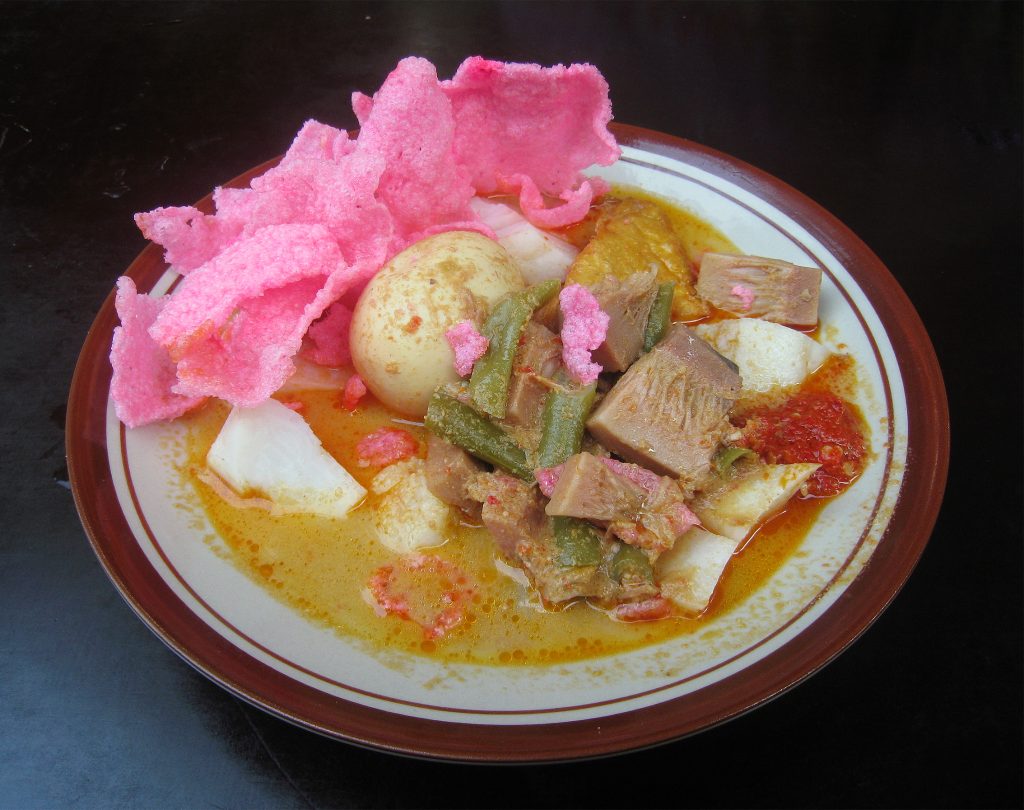
Lontong is a compressed rice cakes usually used to pair with curries or stews. Sometimes, it is also used as an accompaniment for peanut based sauces. Singaporeans also use the term lontong to refer to a vegetable stew in coconut curry mixed with the compressed rice.
Lontong is traditionally wrapped in cylinder-shaped banana leaves, which becomes infused with the leaf’s aroma and is given a greenish color. To make this rice cake, the banana leaves are cut into rectangular pieces and are then rolled into cylinders. The rice is filled into the cylinders, leaving some room for it to expand while cooking. This is boiled for about four hours or until it is fully cooked. It is then unwrapped and cooled.
Cylindrical aluminum tubes are now sometimes used to mold the rice, with banana leaves as lining. Nasi impit is one variant of this dish, wherein a cylinder is not used to make the rice cake. The rice is merely mashed and packed into a lined tray and is then compressed.
Before it is served, the rice is sliced to form small rice cakes. It is often eaten for breakfast or during special events like Malay weddings.
-
Curry Puff
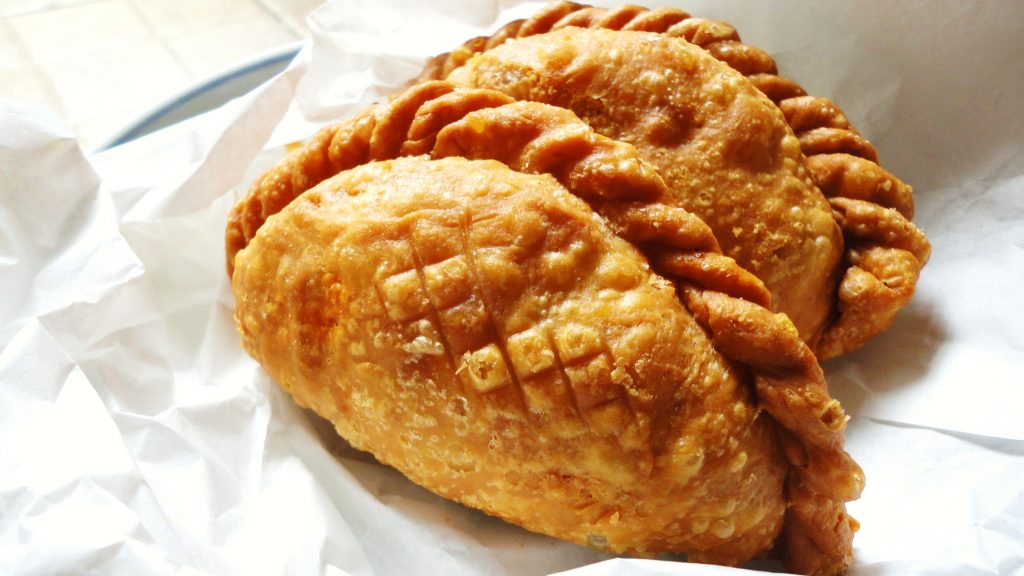
Deep fried and crescent shaped, this pastry is filled with curried potato and some meat. The origin of the curry puff is unknown, but is said to be influenced by the empanada from Portugal, the Indian samosa, and the British Cornish pastry.
It is made up of plain flour and butter, rolled to form a crescent shape. Curried potato fillings and meat are added, and sometimes half a boiled egg. Other versions of this pastry would have chili sardines in its filling. The fillings are precooked before folding them into the pastry.
Malay women used to sell epok-epok – a fried pastry with sardines or potatoes as filling, with a spice blend but no curry – in houses, paired with some sweet and sour chili sauce. Bean sprouts are sometimes added to this pastry to for more flavor. The curry puff’s crescent shape was influenced by the Muslim beliefs of the pastry makers. Eventually, this pastry was adopted by the Chinese and was given a twist – adding boiled egg inside.
Newer variants of this pastry have chicken and onion in it instead of potatoes, and some would mold it into different shapes aside from the original crescent.
-
Roti John
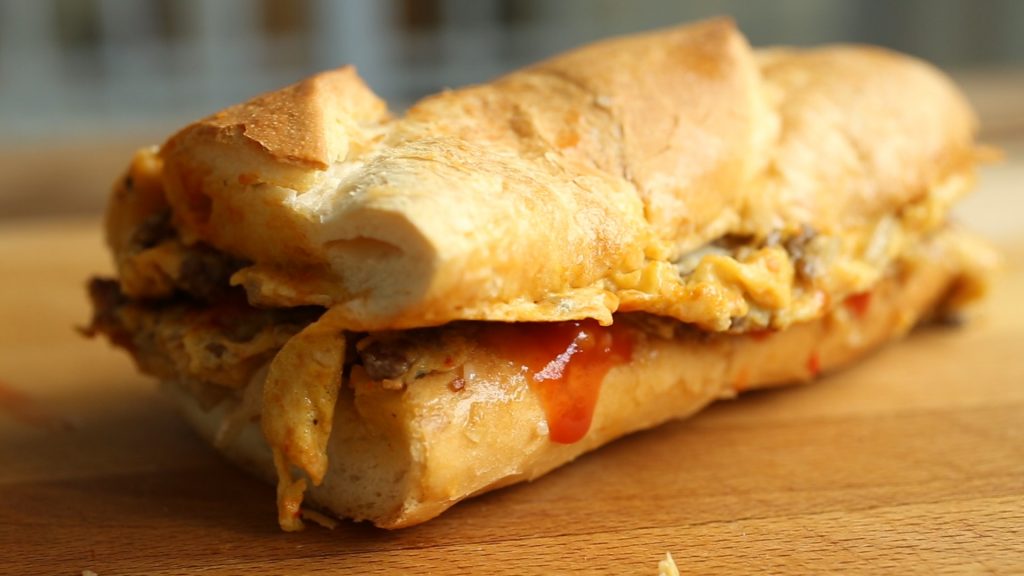
Roti john is a dish made out of a loaf similar to a French baguette and is sliced in halves. This is fried with some minced mutton, onions, and egg for toppings. It is said to be unique to the Malay peninsula, and literally means “John’s bread.” John was a term used to address Caucasians, while roti is Hindi for bread.
This local dish is sometimes known as the Singaporean version for burger. It is made from a local bread loaf that is shorter than a French baguette and has round ends. This meal is crispy on the outsides, with soft mutton meat and eggs plus crunchy onions on the insides. This is paired with some green chili, tomato sauce, and sweet chili sauce. Aside from mutton, other versions of this dish would use chicken, beef, or sardines. Newer variants would even have melted cheese and mushrooms inside.
The origin of this dish is quite interesting. According to an article, an Englishman asked a Malay hawker for a hamburger. This was not sold in the area back in the day, so the vendor improvised by spreading minced mutton and onions between a sliced French loaf and fried it in egg.
Another article said that the roti john has been adapted to local tastes and that its original version consisted of mutton, scrambled egg, some salad greens, and tomato with French bread. They were sold by Indians most especially to British soldiers. Now, the dish is served all over the Malay peninsula.
-
Mee Siam
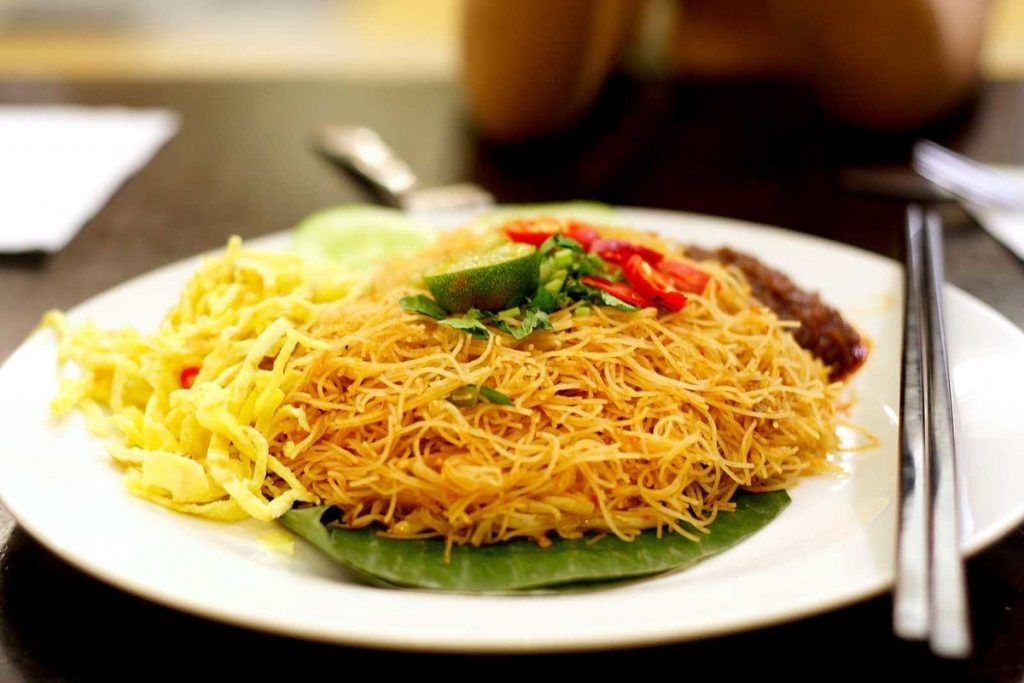
Mee Siam is made up of bee hoon (rice vermicelli) mixed with sweet and tart flavored gravy. This dish is said to be influenced by the Thais, and that its name refers to Thailand’s old name, ‘Siam.’ Other people believe that this dish originated from the Malays. Mee siam is a Malay term for ‘fried noodes.’ The dish was one of the meals served in hawkers near the Esplanade back then.
The flavors of mee siam gravy is very similar to those of Thailand. The gravy is made from tamarind, sugar, shrimp, shrimp paste (belacan), and soya bean paste (taucheo). This is mixed with the bee hoon, with some hard-boiled egg, fried bean curd, beans prouts, and Chinese chives for toppings, and an amount of sambal tunis (a type of chili paste) for its finish.
Many variants of this dish can be found in Singapore – like the Chinese, Malay, Peranakan, and Indian versions. Chinese mee siam uses a blanched bee hoon which is the fried in gravy made out of a mixture of chili paste and ground dried shrimps. It uses chicken, thinly sliced omelette, and other ingredients for toppings.
The Indian version uses coconut in the gravy, making its color appear lighter while the Malay variant does not use coconut in it. Peranakan mee siam uses curry powder and blue ginger (galangal).
-
Naan

Baked in a traditional clay oven called the tandoor, Naan is a teardrop-shaped bread that is served with different types of curry. The tandoor is said to have originated in central Asia, even though it is usually associated to Indian cuisine.
The dough of naan bread is made up of flour with baking powder and dry yeast to produce the right texture. The ingredients are first added into the dough, and then they are kneaded and left to rise. A damp cloth is placed to keep the dough moist. Once it has risen, the dough is shaped into flat pancakes. The sides are pulled down to for the teardrop shape that it is known for. It only takes less than three minutes to bake the naan.
This bread is served whole or cut, and is usually paired with curry, tandoori chicken, or vegetables. Naan bread is actually rich in protein and B vitamins and is best eaten when fresh from the tandoor.
Newer variations are now being made aside from the plain, garlic, or butter naan. Keema naan is a new version which contains minced mutton, onion, ginger, and green chili for its filling. Kashmiri naan is another variant that has a filling of dried fruits and mixed nuts. Masala naan has mashed potato, cottage cheese, and spices in its insides.
-
Putu Piring
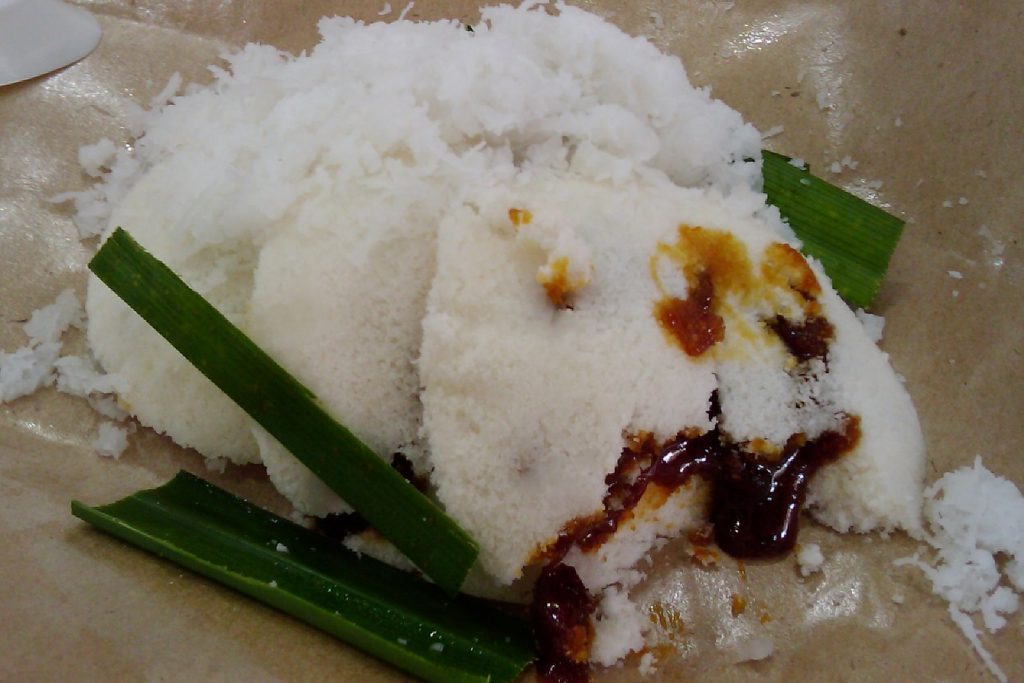
A round-shaped steamed rice cake, Putu Piring is a popular snack especially for local Malays. ‘Putu’ is a Tamil word for something made with flour and coconut, while ‘Piring’ is a Malay word for saucer. This rice cake has a melted palm sugar (gula melaka) filling inside. It is shaped using a mold, which is then added with the palm sugar in the middle before topping it with another layer of rice flour. The molded rice cake is steamed for a few minutes only. Once it has been cooked, it is topped with grated coconut.
This rice cake would melt in your mouth if the flour was sifted well before steaming. It can be eaten either hot or cold, and is usually served for breakfast. Putu piring is also served on special events like during the month of Ramadan for the Muslims.
A different version of the putu piring is called the putu bamboo, which, as the second word in its name implies, uses a bamboo to shape the rice cake. It uses the same ingredients as the putu piring, but its finished product is different. It is also usually wrapped in coconut leaves.
-
Kuih Tutu
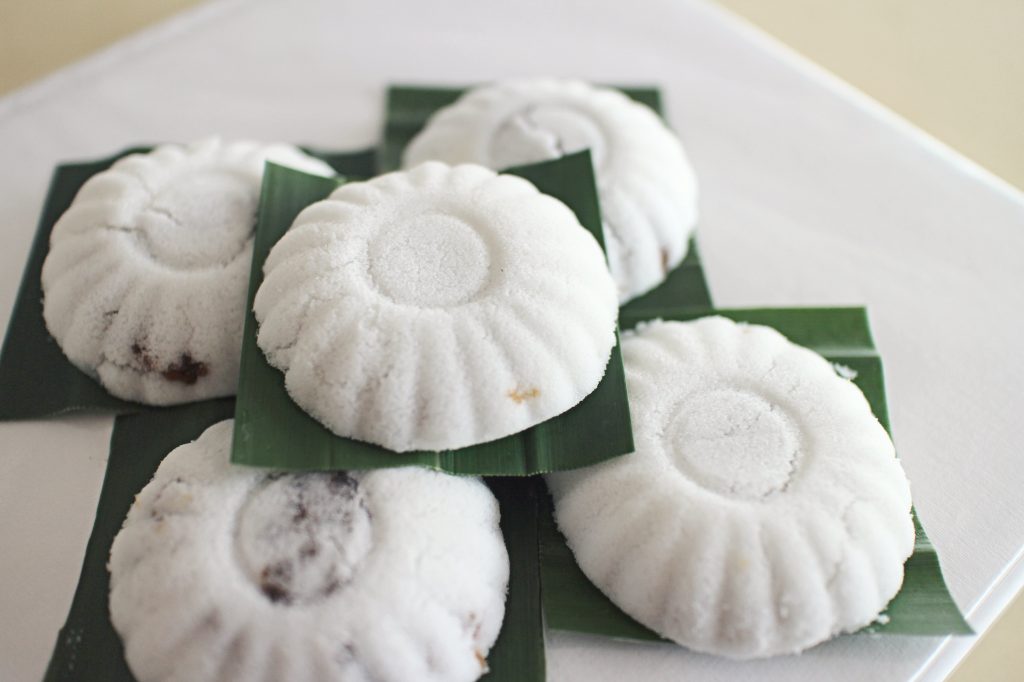
Last on the list is the kuih tutu, which is also a steamed rice cake similar to that of the putu piring. It is made of rice flour and has either finely chopped peanuts or freshly grated coconut for its filling. Kuih tutu is said to have a Chinese origin, and is an exceptional Singaporean rice. Malay influences contributed to the idea of using peanut and coconut as filling.
Kuih tutu is crafted out of finely pounded rice flour steamed in a specially made mold. The mold is partly filled with the rice flour, which is then added with some filling – peanuts or coconut. An additional layer of pounded flour is then topped to the combined filling and the rice cake is placed in the steamer. Kuih tutu follows the flower shape of its mold, and is put on top of a pandan leaf before it is served. The pandan leaf helps add more flavor and aroma to the rice cake. Sometimes, this is sold without any filling, which is why the rice flour has a touch of sweetness to add some flavor even when there is no filling.
Most of the dishes listed can mainly be found in hawker centers all over Singapore. As seen from the list, the country does not only serve a variety of dishes, but it also offers different versions for one dish, depending on the vendor’s line of influence or origin. Despite its small size, the country is able to showcase a selection of some of Asia’s delectable cuisine.
By trying Singapore’s many different dishes, you get to experience not only the wonderful flavors from varying cuisines, but you also get a glimpse of the history and influences of the country. Who knew that a such a small country could hold such a wonderful history, even in its food? Don’t you think it is an exciting experience to be able to try some local Chinese cuisine on the left, and a completely different Indian dish when you turn to the stall to your right? Aside from being overwhelmed with the unique dishes served in front of you, let your food trip in Singapore also be a fun learning experience.
__________________________
We spent a lot of time researching and writing this article. If you think it’s valuable – please share link to this article on your Social Media or Website. Thx a lot!
Related links :



